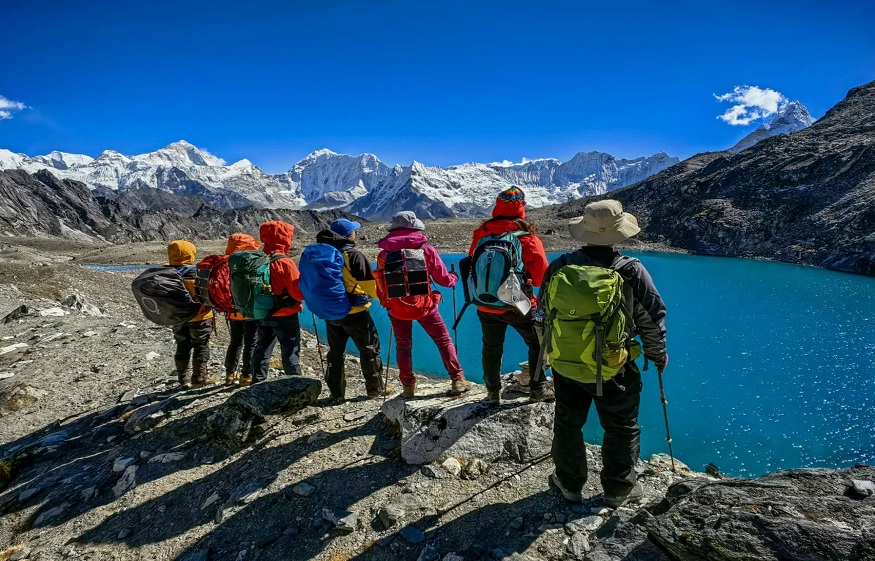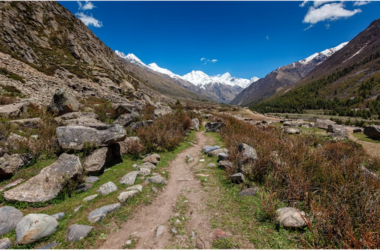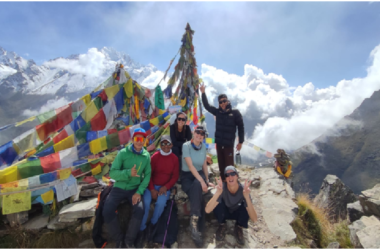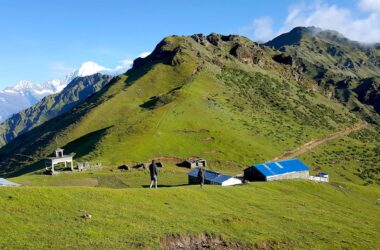The Everest Three High Passes Trek is one of the most interesting and difficult trekking routes in the world. This coverage, through the Revelation of the Everest region, consists of crossing three high passes—Kongma La, Cho La, and Renjo La—all of the while presenting their very own difficulties and prizes. Although the trek offers unrivaled views of some of the highest peaks in the world, it’s not for the faint of heart. That’s where Sherpas come in.
The indigenous people of the Everest region, Sherpas are expert guides with an unrivaled knowledge of the mountains, routes, and local culture. Having a Sherpa guide you through the high-altitude passes and keeping you safe is crucial to traveling in this region. They are also masters of acclimatization techniques, which is critical for avoiding altitude sickness — a common issue at these high-altitude elevations. Sherpas pace the hike, allowing for plenty of rest days at critical waypoints to help trekkers adapt to the thinning air and reduce their chances of altitude-related health issues.
Sherpas are also knowledgeable about local culture and customs and provide a more authentic experience. As they are natives of the Khumbu Valley, they share stories about the local traditions, Buddhist beliefs, and the area’s rich history. Not only does it make the trek safer, but many trekkers say it also makes it more meaningful, immersing them in the culture and spirituality of the Everest area. Everest Three High Passes Trek with Sherpa is a once-in-a-lifetime experience that combines adventure, culture, and unparalleled beauty.
Everest Three High Passes Trek Overview
Everest Three Pass Trek Altitude One of the most exciting and difficult trekking routes in the Himalayas is the Everest Three High Passes Trek. It is a circuit trek that spans three high-altitude passes — Kongma La, Cho La, and Renjo La, all of them above 5,000 meters. These passes provide breathtaking vistas of the world’s highest peaks, namely Mount Everest, Lhotse, Makalu, and Cho Oyu. The trek is perfect for experienced trekkers searching for a challenging trek without the crowds of the Everest Base Camp route. Trekking routes take trekkers through traditional Sherpa villages, remote monasteries, and pristine landscapes. This trek showcases not only spectacular natural beauty, but opportunity to experience Sherpa culture and traditions. The Everest Three High Passes Trek, characterized by its rugged terrain, challenging weather conditions, and high-altitude obstacles, necessitates rigorous physical preparation and gradual acclimatization for a safe and successful journey. These with trek that lasts around 18-20 days though this includes visiting Everest Base Camp, Gokyo Lakes, challenging yourself, and if you want an unforgettable journey.
What is Trekking with Sherpas on the Everest Three High Passes
Now, there are numerous advantages of trekking with Sherpas on the Everest Three High Passes route that can help you have a safer, smoother, and more enriching journey. Sherpas, born in the Everest region, have an intimate understanding of the terrain, climate, and altitude obstacles and form an essential component of any expedition. Their experience helping trekkers through tricky passes, recognizing local weather patterns, and identifying early signs of altitude sickness is critical to our safety. Besides their skills in mountaineering, Sherpas also offer insights to the local culture, traditions, and religious practices, adding to the overall experience. They are also logistically minded, ensuring that trekkers have the appropriate permits, lodging, and meals en route. The Sherpas’ capacity to carry heavy loads, establish cam,p and prepare meals for expedition members makes trekking less arduous for trekkers, leaving them free to concentrate on the physical challenge. One of the top advantages of trekking with Sherpas is the camaraderie; their upbeat and encouraging personality can keep your spirits high through the more strenuous legs of the trip. Having Sherpas in support and as a guide will pray are the sure possible solution for a hard path with either no trouble or even a success story.
Trekking Route and Important Passes Overview
Everest Three Pass Trek Best Time The Everest Three High Passes Trek is a memorable circuit route through the Everest region that links various remote villages, alpine meadows, and ancient monasteries. The Trek starts in Lukla, where trekkers fly in from Kathmandu, and follow a Marry way through Namche Bazaar(the heart of Khumbu region) before continuing to higher altitude. Along the way, trekkers cross three big passes — Kongma La, Cho La, and Renjo La — all above 5,000 meters. Kongma La (5,535 meters), the first pass is a steep slog; the sweeping view out over Everest and the neighboring peaks Lhotse and Makalu. After descending from Kongma La, trekkers continue on to Cho La (5,420 meters), where crossing a glacier makes this one of the more technical sections of the trek. At last, trekkers come to Renjo La (5,360 meters), the last of the high passes and one that provides one of the most dramatic panoramic views of the Himalayas. Along with the passes, the trek takes you to Everest Base Camp, the Gokyo Lakes, and the Gokyo Ri viewpoint. A complete and challenging route for adventurous trekkers. This entire trek is around 18 to 20 days in the circuit with enough acclimatization and rest days integrated into your schedule so that the trekkers can be suited to the high altitudes and rugged terrain.
This is the must-know Before you go to Everest Three high passes
Trek to Everest Three High Passes is no easy trek; it needs to be well prepared. This trek is rigorous and combines endurance, practical skills, and fitness. From a physical perspective, trekkers should train for cardio endurance, strength, and endurance. I think hiking, running and cycling are all fantastic for building cardiovascular fitness. Strength-training exercises for the legs and core should prepare trekkers to deal with the steep ascents and difficult rocky terrain that will be encountered on the trail. Walking, in particular, is important practice because trekkers will be hauling gear along some stretches of the route, and with a loaded backpack, if possible.
Mental preparation is as important as physical conditioning. The trek includes long days of hiking at high altitudes, and developing mental resilience is essential to push through feelings of fatigue or discomfort. Data up to this point can be used to mold visualization of the trek, managing realistic work goals, and practice mind control and concentration can be a good way to manage stress levels and keep the motivation up during the process. Additionally, understanding the topography, weather conditions, and challenges related to the trek will assist you in preparing for what is in store.
Everest Three Pass Trek Trekking Permit Acclimatization is one of the critical tasks for preparation. The trek is at a high altitude and requires trekkers to give their bodies time to acclimatize to the thin air. That’s accomplished by taking a slow and steady approach, with rest days that facilitate adequate acclimatization and hydration. Last but not least, consider packing the necessary gear for the trek, such as a proper trekking boot, layers of clothing, and a high-quality sleeping bag for colder temperatures at high altitudes.
Important: Sherpas and Their Role in Your Trek
What makes the Everest Three High Passes Trek successful is the Sherpas. These local men, who all grew up in the region surrounding Everest, have an intrinsic knowledge of the land, the climate, and the perils of summit mountain climbing. They have experience going up steep slopes, technical passes, as well as bad weather. They possess expert knowledge of acclimatization techniques, which is essential in preventing altitude sickness and keeping trekkers safe as they move to higher altitudes.
Sherpas not only lead trekkers through grueling terrain, but they also manage logistics for the trek (like establishing camps, coordinating meals, organizing required permits, and facilitating travel). They are familiar with the early signs and symptoms one experiences from high mountain sickness, so they help mitigate those.
Sherpas also play a huge role in the cultural element of the trek. They provide insight into local Sherpa culture, traditions, and spiritual practices, enhancing the journey and offering trekkers a better understanding of the region. They do much more than just guide and carry the bags, they are a source of encouragement, support, and the company needed during the long, hard days of an arduous trek.
Advice for Acclimatization and Safety at High Altitude
One of the main factors for a safe and successful Everest Three High Passes Trek is acclimatization. The trek includes elevations of more than 5,000 meters, where oxygen levels are significantly reduced and the risk of altitude sickness is much higher. To reduce the risk, trekkers must stick to a deliberately slow ascent schedule, giving their bodies time to acclimatize to the thinning air.
The most common acclimatization strategy is the “climb high, sleep low” strategy. That means hiking as high as possible during the day and then coming back down to sleep at a lower elevation so that the body can prepare to tackle higher altitudes without straining itself. You can also ensure that you take regular rest days after crossing each pass or reaching a high point. Climbing is exhausting, so there are rest days built in to allow trekkers to recover and better adapt before moving on.
Everest Three Pass Trek Duration All these factors are also key to altitude safety, along with hydration, nutrition, and rest. Drinking enough fluids, and eating plenty of calorie-dense nutrient-dense food will maintain energy and aid acclimatization. If symptoms of altitude sickness, including headaches, dizziness, or nausea, are experienced, it’s critical to go lower immediately and to seek medical attention, if needed. They are very good at spotting potential symptoms of altitude sickness and are very instrumental in helping trekkers deal with their condition. This is where proper acclimatization practices come into play, which can minimize the risks associated with trekking at a high altitude and increase the chances of being able to complete the Everest Three High Passes Trek.
Essential Gear and Equipment for the Trek
Essential Gear and Equipment for Everest Three High Passes TrekWhen you are planning to do the Everest Three High Passes Trek, it is crucial to have some essential gear and equipment for comfort and safety. The extreme altitude and unpredictable weather of the Everest region necessitates that trekkers be well prepared. Good ankle support and good waterproofing are essential in rough, rocky trails and icy stretches. Ensuring that you stay warm at night with freezing temperatures is having a sleeping bag up to the task such as one rated for sub-zero use.
The trick is layering to dress appropriately. Moisture-wicking base layers, insulating mid-layers, and a waterproof, windproof outer jacket are all part of the temperature management equation. A down jacket is very useful for extra warmth on the colder sections of the trek. And remember a hat, gloves and scarf to ward off the cold and wind.
Also, trekking poles are important for balance, especially when crossing high passes or difficult and uneven terrain. You also need a comfortable backpack that can carry basic items like a water bottle, snacks, sunscreen, and a first-aid kit. Portable chargers are recommended to charge your devices. Sherpas also have a big role in assisting trekkers with packing and ensuring they only carry essentials, making it as smooth and comfortable of a journey as possible. The right gear is critical to success and enjoyment on the Everest Three High Passes trek.
The Obstacles You Will Encounter on the Journey
Without a doubt, the Everest Three High Passes Trek is one of the most grueling treks in the world that poses a unique combination of physical, menta,l and environmental challenges to trekkers. The three high-altitude passes — Kongma La, Cho La, and Renjo La — each offer their own share of challenges, from steep climbs and rocky trails to inclement weather and bitter temperatures.
Altitude sickness is one of the biggest risks for trekkers during this trek. The trek climbs above 5,000 meters, where oxygen is in short supply, and acclimatization is critical. If they don’t help their bodies adjust, trekkers can develop symptoms like headaches, dizziness or nausea. This risk can be managed by trekking slowly, taking regular days off, and paying attention to Sherpa’s advice to ensure proper altitude adaptation.
Another big challenge is the weather. Due to unpredictable weather in the Everest region, sudden snowstorms or high winds could close high passes. Experience is key to navigating such weather conditions, so the expertise of Sherpas is essential. The physical challenge of traversing rocky terrain and steep climbs, especially while wearing a full backpack, contributes as well to the difficulty of the trek. But, in spite of those obstacles, the rewards of breathtaking panoramic vistas, satisfaction, and the ability to soak up the beauty of the Himalayas seem to make those challenges more than worth the effort.
Sherpa’s wisdom in navigating the terrain
The Everest Three High Passes now eases itself into its complexities, paving with the majesty of the rugged terrain; blinking lights however big the sun is; knowing how to strut in the brittle low air. That’s where Sherpas are an invaluable asset. The Sherpas, who are native to the Khumbu Valley, know the mountains like the back of their hands and are experts at navigating trekkers across Everest regions.
Kongma La, Cho La, and Renjo La — the passes themselves — are notoriously difficult, with steep inclines, icy paths, and narrow ridges. Sherpas are experts at selecting the best route to navigate, recognizing hazards along the way, and adapting to the weather as it develops. With knowledge of reading the terrain, they help trekkers across glaciers, rocky slopes, and terrains with avalanches or rockfalls, making the journey safer.
Sherpas are also adept at advising trekkers on how to adjust their pace according to the terrain and altitude. Although this may make them want to try to move quickly, they appreciate that slow and steady wins the race and this will help them from being exhausted and having altitude sickness. Their familiarity with local trails, along with their intuition about how conditions may shift, helps keep trekkers on track. Sherpas are essential when navigating high-altitude passes or tricky routes, making the trek less of a grind and the experience safe and memorable.
Observation of Local Cultures and Traditions
Everest Three High Passes Trek — More Than One Adventure! The Sherpas, the native people of the region, provide essential insights about the local culture, spirituality, and history of the area that lends richness to the trek.
The Sherpas practice Tibetan Buddhism and their beliefs are intertwined with the Everest region. Trekkers will be passing prayer flags fluttering in the wind, stupas (Buddhist shrines), and monasteries, which are all acts of peace prayer, and respect for the mountains along the route. Sherpas frequently tell stories about these spiritual sites, detailing their role in local culture. One of the most significant religious landmarks is Tengboche Monastery, a visit that provides trekkers a taste test of the spiritual nature that pervades the crest of the world.
Sherpas also talk about their family histories, about how their ancestors have lived in the mountains for centuries and about their place in the history of Mount Everest expeditions. These cultural exchanges not only bring trekkers closer to the land being traversed but also add depth to the experience that goes beyond the physical demands of the treks.
Trekking with Sherpas gives you insight into the customs, rituals, and day-to-day life of these magnificent people who live amongst the world’s highest peaks in the Himalayas.
Trekking Safety & Emergency Support
Due to the extreme altitude, challenging terrain, and changeable weather conditions, safety is of paramount importance on the Everest Three High Passes trek. Because trekking at such heights can be deadly, trekking with a Sherpa gives—quite literally—a fighting chance to keep you healthy throughout the trek.
Sherpas are trained in high-altitude first-aid, and they are skilled in identifying the symptoms of altitude sickness that can affect even the most experienced trekkers. They help maintain a slow but steady pace for the group take frequent rest days to ensure proper acclimatization and monitor trekkers for signs of fatigue or health problems. If acute altitude sickness or other medical issues arise, Sherpas spring into action, sometimes shepherding trekkers to lower elevations to recover and, if needed, facilitating emergency medical evacuations.
Sherpas dispense not only medical support but also knowledge of the possible threats the terrain presents, including avalanches, rock slides, and rapid shifts in weather. Having knowledge of these risks, along with the avoiding measures, makes sure that trekkers travel on safe paths and decide appropriately when to continue or take a break. In emergencies, Sherpas are experienced at liaising with helicopter rescue services, so an emergency response happens quickly.
While short treks can be completed without a sirdar or support staff, hiring one can ensure that even the toughest trails can be completed without too much hassle.
Conclusion on getting the best out of your trek with Sherpas
The Everest Three Pass Trek Experience is an unforgettable itinerary to unleash the beauty of the Himalayas. But it’s also a grueling and challenging journey, and having the right support is critical to success. This is where the Sherpas come.
Sherpas are far more than just guides — they are experts in high-altitude trekking, deft navigators of rugged terrain, and culturally knowledgeable ambassadors. Their expertise guarantees trekkers are safe, acclimatized, and equipped for the physical demands of passing over high elevations. They help mitigate risks like altitude sickness, advise on the best gear/equipment, and offer insight into the culture, spirituality, and history of the Everest region.
However, with Sherpas, trekking turns into a truly unforgettable journey, making it more delightful through their expertise, hospitality, and cultural knowledge. As you make your journey through the Everest Three High Passes with Sherpas by your side, you won’t just be achieving a physical endeavor but a once-in-a-lifetime journey that has enough exploration to treasure for an eternity.




